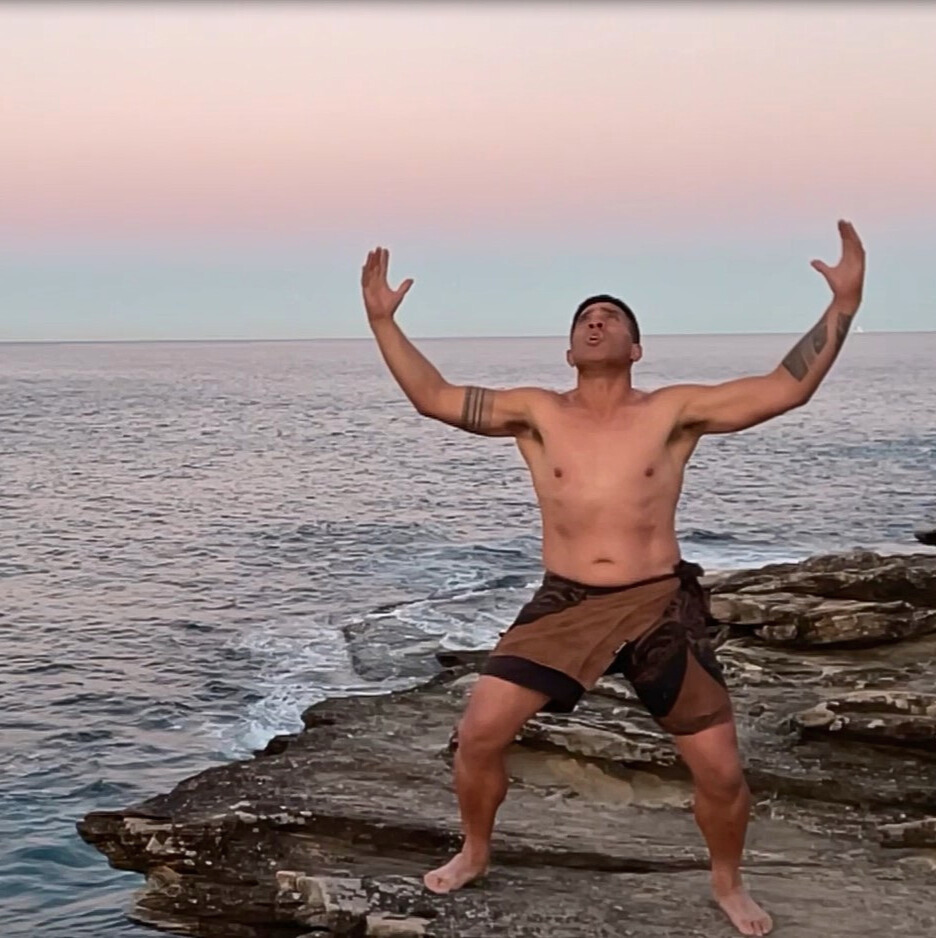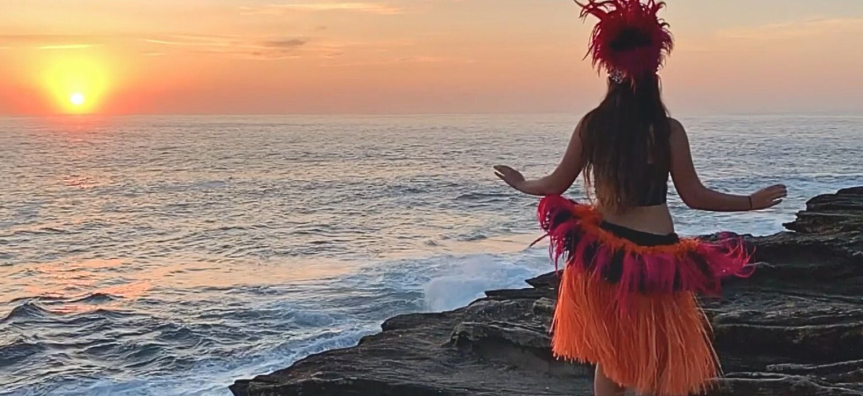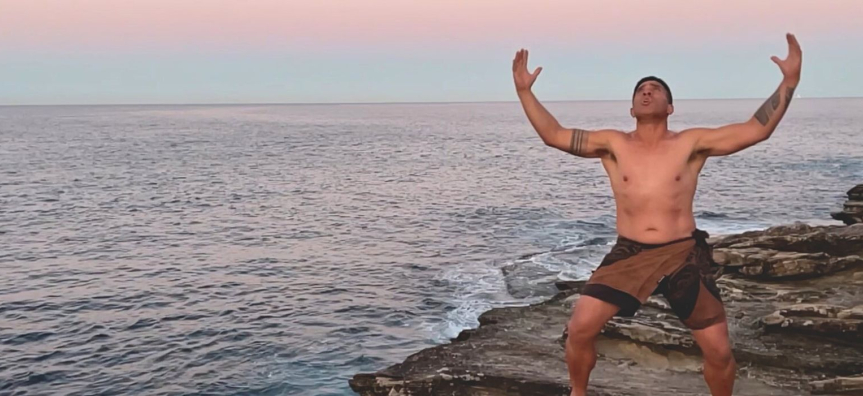
Maxwell Marsters has captured his cultural connection to the ocean in mesmerising slow motion. His short film opens with a closeup of waves crashing against rocks as if viewed through a kaleidoscope, then fades to family members performing traditional Polynesian dance as the sun rises over the ocean behind them. It's an evocative exploration of his heritage and his own relationship with the ocean.
This video artwork was produced for an HSC Visual Arts project, and recently featured in the Out Front 2024 exhibition at Manly Art Gallery & Museum. The exhibition celebrated 30 years of Express Yourself, the annual exhibition of local HSC students.
The title of your work is Pākoko , which has a few different meanings in Māori.
Why did you choose this word to represent your work?
I wanted my body of work to have a title that reflected my Polynesian heritage. I chose the title Pākoko as it is the name of a Polynesian fish that also lives, thrives, and shares our ocean. Interestingly it is also the name given to a figurehead of a fishing canoe in Māori New Zealand culture.
Your work is a short film projected on the wall of Manly Art Gallery & Museum.
Why did you choose film as the medium, and why are the time-based possibilities of film important for the ideas in the work?
Time-based forms allowed me to capture the natural beauty of the landscape while combining the mesmerising movements created in both cultural dance and the ocean.
Film proved to be the most suitable medium to communicate my concept, opposed to more traditional mediums of painting and drawing which are limited with only a 2-dimensional representation.
Members of your family are featured in the work. For those who haven’t seen the work, could you describe what they are doing in the film and how this expresses a connection to culture you’re representing in the film?
In my work I have filmed my cousin performing a traditional Cook Island dance whilst wearing a cultural costume called the Titi. This ‘skirt ‘ made of feathers is worn around the waist and accentuates the movements of the women’s hips when dancing. I have also positioned her dancing on the headland overlooking the beach at sunrise as the beauty of the sky was reflected in the vibrant warm colours of her costume.
My brother and father are both featured in the work performing various sections of a Cook Island Haka on the sand, in the water or by the ocean. I manipulated the speed of the dancing and movements in my work, experimenting with slow motion to immerse the viewer.
It sounds like you come from a creative family of skilled performers. Is the creative expression of culture important to your family, and how has this influenced your own artistic practice?
Dance as a creative expression is extremely important in my culture as it forms the basis of most family celebrations. Cultural traditions from both my Samoan and Cook Island heritage have been passed down to myself, my siblings, and my cousins from our elders which we embrace and endeavour to keep and continue to pass on to future generations.
In terms of Visual Arts, I do come from a line of creative people. My grandmother is an artist, and my mum is a Visual Arts teacher, so I have always been exposed to the art world and I value art.
You've described your work as an exploration and celebration of your personal connections to your Polynesian cultural heritage.
What did you learn about your culture and your relationship to it through the process of making the film?
Through the creation of my work, I was able to discover the origins of my Polynesian people and their connection to land and sea. It enabled me to understand the true importance of the ocean to Island people as it is a place that provides food, travel, and income. It is also how Island people have voyaged and relocated to countries like Australia and New Zealand for new beginnings and opportunities.
The ocean appears as another figure in this work, dancing in slow motion.
How would you describe your personal connection to the ocean?
I have grown up on the Northern Beaches and spend a lot of time enjoying our beautiful beaches that we have on our doorstep. As a young child I was a member of Manly Surf Club and competed in Nippers every Sunday morning. The beach is a place that I can always enjoy and relax, and it is important to my overall wellbeing.
Do you have a favourite beach or ocean lookout on Northern Beaches?
Now I would have to say that Freshwater pool and beach are my favourite places to hang out with friends and recover after early morning or evening gym sessions.
You’ve said your work is inspired by the artist Shaun Gladwell, whose works can be described as ‘video performance’, although we can see you’ve put your own spin on this type of work.
Can you tell us more about Gladwell’s work and what inspired you? Are there other influences that have influenced the way you work?
I found the contemporary works of Gladwell immersive and captivating to watch. I particularly liked his film titled “Storm Sequence” which is footage of a man skateboarding by the ocean.
I was also inspired by the work of Euan Macleod as he also integrates his figures into the landscape. I was influenced by this concept in my own body of work, however I used film instead of paint as it gave me endless possibilities to manipulate and edit whilst endeavouring to keep the landscape ‘untouched’ but exaggerated instead.
The film has two different types of imagery, human bodies dancing in the landscape and kaleidoscopic imagery of waves swirling around. Both of which are mesmerising to watch!
What did you want to achieve by mixing these two images/ideas? And, why did you choose to manipulate the imagery of water in this way?
The manipulation of the ocean came from the idea of Polynesians people entering new land as they seek new possibilities and beginnings. As the film progresses this editing process lessons as my people find their feet and feel connected.
Would you like to continue making artwork like this, perhaps other types of film or other types of art?
To be honest I have not really given much thought into pursuing art or film since leaving school, as I currently have other areas of focus moving forward into the future.
What stories and ideas do you think are important to make art about?
Honestly, I believe if artists are making works that are important and personal to them in a subjective way, then they will be successful in communicating those ideas to audiences.



